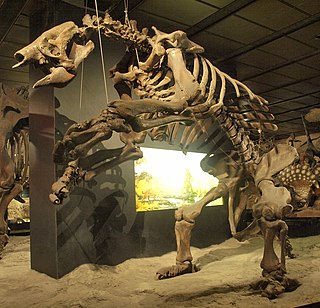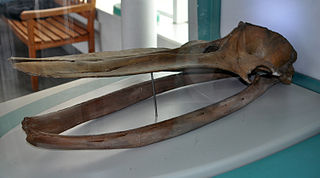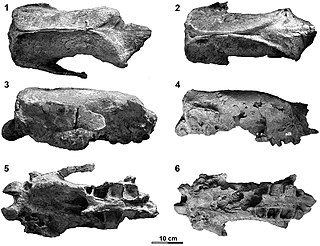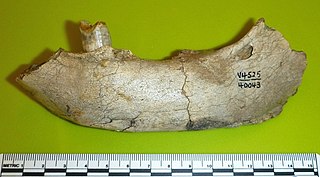Phoberomys is an extinct genus of rodents. Fossil specimens from the Late Miocene period have been discovered in the Ituzaingó Formation of Argentina, the Solimões Formation of Brazil, the Urumaco Formation at Urumaco in Venezuela, and the Pliocene of Peru.

Archaeoindris fontoynontii is an extinct giant lemur and the largest primate known to have evolved on Madagascar, comparable in size to a male gorilla. It belonged to a family of extinct lemurs known as "sloth lemurs" (Palaeopropithecidae) and, because of its extremely large size, it has been compared to the ground sloths that once roamed North and South America. It was most closely related to Palaeopropithecus, the second largest type of sloth lemur. Along with the other sloth lemurs, Archaeoindris was related to the living indri, sifakas, and woolly lemurs, as well as the recently extinct monkey lemurs (Archaeolemuridae). The genus, Archaeoindris, translates to "ancient indri-like lemur", even though it probably became extinct recently, around 350 BCE.

Purussaurus is an extinct genus of giant caiman that lived in South America during the Miocene epoch, from the Friasian to the Huayquerian in the SALMA classification. It is known from skull material found in the Brazilian and Peruvian Amazon, Colombian Villavieja Formation, Panamanian Culebra Formation, Urumaco and Socorro Formations of northern Venezuela.

Megalonyx is an extinct genus of ground sloths of the family Megalonychidae, native to North America. It evolved during the Pliocene Epoch and became extinct during the Quaternary extinction event at the end of the Late Pleistocene-Early Holocene, living from ~5 million to ~13,000 years ago. The type species, M. jeffersonii, the youngest and largest known species, measured about 3 meters (9.8 ft) in length and weighed up to 1,000 kilograms (2,200 lb).

Thalassocnus is an extinct genus of semiaquatic ground sloths from the Miocene and Pliocene of the Pacific South American coast. It is monotypic within the subfamily Thalassocninae. The five species—T. antiquus, T. natans, T. littoralis, T. carolomartini, and T. yuacensis—represent a chronospecies, a population gradually adapting to marine life in one direct lineage. They are the only known aquatic sloths, but they may have also been adapted to a terrestrial lifestyle. They have been found in the Pisco Formation of Peru, the Tafna Formation of Argentina, and the Bahía Inglesa, Coquimbo, and Horcón formations of Chile. Thalassocninae has been placed in both the families Megatheriidae and Nothrotheriidae.

Eremotherium is an extinct genus of giant ground sloth in the family Megatheriidae. Eremotherium lived in the southern North America, Central America, and northern South America from the Pliocene, around 5.3 million years ago, to the end of the Late Pleistocene, around 10,000 years ago. Eremotherium was widespread in tropical and subtropical lowlands and lived there in partly open and closed landscapes, while its close relative Megatherium lived in more temperate climes of South America. Both genera reached the size of today's elephants and were among the largest mammals in the Americas. Characteristic of Eremotherium was its robust physique with comparatively long limbs and front and hind feet especially for later representatives- three fingers. However, the skull is relatively gracile, the teeth are uniform and high-crowned. Like today's sloths, Eremotherium was purely herbivorous and was probably a mixed feeder that dined on leaves and grasses. Eremotherium was a generalist that could adapt its diet to the respective local and climatic conditions of many regions. Finds of Eremotherium are common and widespread, with fossils being found as far north as South Carolina in the United States and as far south as Rio Grande Do Sul, and many complete skeletons have been unearthed.

Gryposuchus is an extinct genus of gavialid crocodilian. Fossils have been found from Argentina, Colombia, Venezuela, Brazil and the Peruvian Amazon. The genus existed during the Miocene epoch. One recently described species, G. croizati, grew to an estimated length of 10 metres (33 ft). Gryposuchus is the type genus of the subfamily Gryposuchinae, although a 2018 study indicates that Gryposuchinae and Gryposuchus might be paraphyletic and rather an evolutionary grade towards the gharial.
Prepotherium is an extinct genus of megatheriid ground sloths that lived during the Miocene period. Fossils of Prepotherium have been found in the Collón Curá and Santa Cruz Formations of Argentina.

Piscobalaena is an extinct genus of cetaceans, which lived from the Middle to Late Miocene epochs in Peru and Florida. Its fossils have been found in the Pisco Formation of Peru and the Bone Valley Formation of Florida. At least some individuals of this diminutive whale were preyed on by the shark O. megalodon.
Globidentosuchus is an extinct genus of basal caimanine crocodylian known from the late Middle to Late Miocene of the Middle and the Upper Members of the Urumaco Formation at Urumaco, Venezuela. Its skull was very short and robust, with large units of spherical teeth used to break the shells of molluscs as part of its durophagus diet. It is thought to be one of the most basal Caimanines, even sharing some traits with alligatorids.

Nothrotheriidae is a family of extinct ground sloths that lived from approximately 17.5 mya—10,000 years ago, existing for approximately 17.49 million years. Previously placed within the tribe Nothrotheriini or subfamily Nothrotheriinae within Megatheriidae, they are now usually placed in their own family, Nothrotheriidae. Nothrotheriids appeared in the Burdigalian, some 19.8 million years ago, in South America. The group includes the comparatively slightly built Nothrotheriops, which reached a length of about 2.75 metres (9.0 ft). While nothrotheriids were small compared to some of their megatheriid relatives, their claws provided an effective defense against predators, like those of larger anteaters today.

The Pisco Formation is a geologic formation located in Peru, on the southern coastal desert of Ica and Arequipa. The approximately 640 metres (2,100 ft) thick formation was deposited in the Pisco Basin, spanning an age from the Middle Miocene up to the Early Pleistocene, roughly from 15 to 2 Ma. The tuffaceous sandstones, diatomaceous siltstones, conglomerates and dolomites were deposited in a lagoonal to near-shore environment, in bays similar to other Pacific South American formations as the Bahía Inglesa and Coquimbo Formations of Chile.
The Urumaco Formation is a formation in Venezuela that includes deposits from the Late Miocene. It is the site of several "giant forms": the turtles, crocodiles, sloths and rodents of Urumaco are among the largest of their groups.
Acresuchus is an extinct monospecific genus of medium-sized caiman from the Late Miocene of western Brazil and Venezuela. The genus contains a single species, Acresuchus pachytemporalis. Acresuchus is a close relative of the giant caiman Purussaurus.

Pseudoprepotherium is an extinct genus of sloths of the family Mylodontidae. It was widespread across northern South America during the Early to Late Miocene epoch around 21 to 5.3 million years ago. Fossils of the animal have been found in Brazil, Venezuela, and Peru. Pseudoprepotherium lived in a tropical climate with a water-rich environment. Their known remains are limited to limb bones, except for a few skulls and teeth. Based on these remains, they were most likely medium to large-sized mylodontid. The genus was described in 1961 and currently contains three species, which were originally assigned to the genus Prepotherium.

Proeremotherium is an extinct genus of megatheriine ground sloths in the family Megatheriidae. It lived during the Late Miocene and Early Pliocene of what is now Venezuela. So far, two largely complete skulls have been recovered in the Falcón Basin in Venezuela. The finds identify the animals as medium-sized representatives of the Megatheriidae. In the cranial anatomy, Proeremotherium resembles the later and giant Eremotherium. It is therefore assumed that the two ground sloths are directly related to each other.
Baraguatherium is an extinct genus of ground sloths of the family Mylodontidae that lived during the Early Miocene of what is now Venezuela. It dates to the Early Miocene, around 20.44 to 15.97 million years ago and represents the oldest representative of its family in the northern part of South America to date. The structure of the teeth suggests that the genus represents a rather basal form within the Mylodontidae. Unlike other mylodonts, which tended to prefer open grasslands, Baraguatherium lived in a riverine, coastal tropical rainforest.
Urumacocnus is an extinct genus of megalonychid sloth that lived during the Miocene in Venezuela. The genus contains one known species, Urumacocnus urbanii. Fossils have been found in the Urumaco Formation of Venezuela.
Bolivartherium is an extinct genus of mylodontine mylodontid sloth that lived during the Late Miocene and Late Pliocene in what is now Venezuela. Fossils have been found in the Codore and Urumaco Formations of Venezuela.

Magdalenabradys is an extinct genus of mylodontid ground sloths that lived during the Middle Miocene and Early Pliocene of what is now Colombia and Venezuela. Fossils have been found in the Villavieja Formation of the Honda Group in Colombia, and the Codore and Urumaco Formations of Venezuela.














